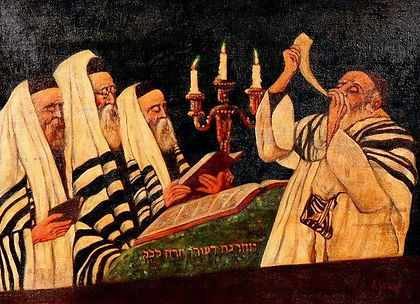IKONI-USKONTOKUVAT
Luonnonuskonnot Hindulaisuus Buddhalaisuus Taolaisuus Kungfutselaisuus Shintolaisuus Juutalaisuus Islam
ORTODOKSINEN KIRKKO KATOLINEN KIRKKO KIRKON ERO 1054 PROTESTANTTISET KIRKOT LUTERILAINEN LIRKKO REFORMOIDUT KIRKOT ANGLIKAANINEN KIRKKO MUITA PROTESTANTTISIA YHTEISÖJÄ SUOMEN KIRKON HISTORIAA
HOLY BIBLE

ROSH HASANA- Jewish New Year
Rosh hasana is a serious celebration to meditate on the evil deeds done during the year and plan how they could compensate their loved ones.
From this day begins a period of ten days of repentance and introspection, ending in Yom Kippur. Rosh hasana worship lasts up to four hours and is then blown up to a hundred times in the rams horn so that people would wake up and think about how they could become better people.

JOM KIPPUR - a great day of atonement
Yom Kippur is the holiest day of the year. Then many Jews alienated from the religion will come to the synagogue to celebrate common celebration.
All adults over the age of 13 fast all day and spend it in synagogue services in repentance.
The day ends with a long blow to the sofar (ram’s horn).

SOCKS - Leaf House Party
During Sukkot, one recalls the temporary huts that the Israelites built during their 40-year wilderness trek. Huts are still being built on the branches and balconies from the branches.
Sukkot also has the meaning of a harvest festival and the fruits and vegetables that hang from the roofs of the huts resemble it.
On the last day of the Sukkot Feast, the Torah is also celebrated, for then it has been read in the synagogue at the end of the year.
The congregation walks the Torah scrolls, carrying around the synagogue, dancing and singing joyfully (this feast calls for

HANUKKA
Here the eight-day celebration commemorates the Maccabean supremacy of the Syrian Greeks who ruled Israel 2,200 years ago. Then (165 BC) they consecrated Jerusalem the temple again.
Every day, one new candle is lit on a 9-pronged candlestick at a party. with a servant candle.
Hanukkah often happens quite close to Christian Christmas and that is why it has also become a favorite party for children. The celebration involves giving gifts to children.

PURIM
Purim is a happy celebration reminiscent of how Esther saved her cunning and, with the help of his uncle Mordecai, the Jewish community of Persia. This is why Purim's most important tradition is reading the book of Esther.
The festive tradition is also associated with enjoying good food and drink

PESAH - Easter
The most important people in the Easter meal are the children. The family gathers for a seder meal, which is enjoyed on the first two festive evenings. That is when the Haggada, or the account of the liberation of Egypt from slavery, is read. Haggada urges every generation to pass on this tradition to their children, as everyone must be able to personally experience leaving Egypt.
The ingredients of the Seder meal and their symbolic meaning are explained to the children:
roasted tibia = biblical temple sacrifice
fried egg = Sacrificial gifts given in the temple
parsley = Easter is equivalent to the spring harvest
a plate of chopped apples, nuts, and wine symbolizes the masonry mortar used by the Israelites in slavery
bitter herbs = The bitterness of slavery
Celebration of SAVUOT weeks
This celebration commemorates the Torah given on Mount Sinai to Moses and the liberation of the people of idolatry.
The first of the party on the day the Torah is studied and the Ten Commandments are read in worship, symbolically referring to the entire Torah.





